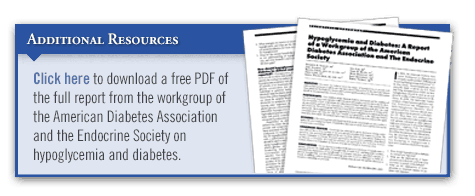In 2009, a clinical practice guideline on the evaluation and management of adult hypoglycemic disorders was released by the Endocrine Society, summarizing how clinicians should manage these problems in patients with diabetes. Since that time, new evidence has become available, further demonstrating the link between hypoglycemia and adverse outcomes. Late in 2013, the American Diabetes Association and Endocrine Society developed new guidance on how hypoglycemia should be incorporated into clinical practice when caring for patients with diabetes.
The 2013 guidelines, published simultaneously in Diabetes Care and the Journal of Clinical Endocrinology and Metabolism, addressed five specific areas, including how hypoglycemia should be defined and reported, the implications of hypoglycemia on short- and long-term outcomes, and the implications of hypoglycemia on treatment targets. The guideline also discussed strategies for preventing hypoglycemia—offering recommendations for those at risk—and knowledge gaps in the understanding of hypoglycemia.
“The most important take-home message from the guidelines is clinicians should recognize that hypoglycemia is a significant problem for patients and is associated with poor outcomes,” says Elizabeth R. Seaquist, MD, who led the workgroup that developed the guidelines. She notes that clinicians often do not realize that hypoglycemia is a risk for patients with type 2 diabetes, who make up the vast majority of diabetes patients in the United States.
Lessons Learned
Evidence is mounting that patients with type 2 diabetes are vulnerable to adverse events associated with hypoglycemia. The guidelines workgroup defined hypoglycemia as a blood glucose reading of less than 70 mg/dL. Severe hypoglycemia episodes were defined as those requiring intervention by others, such as a bystander, paramedics, or emergency room visits.
Over the past decade, three large trials have examined the effects of glucose lowering on cardiovascular events (ACCORD, ADVANCE, and VADT). These studies found that an episode of severe hypoglycemia increased risks for subsequent mortality. The acute risks of hypoglycemia include patients feeling confused, shaky, and sweaty. “These symptoms are inconvenient to patients, but they’re also important because they can impair their ability to perform many tasks, like driving,” explains Dr. Seaquist. “Loss of consciousness from hypoglycemia puts patients at risk for serious injuries or accidents. This is a real concern with hypoglycemia and can actually result in death in some cases.”
“Clinicians should recognize that hypoglycemia is a significant problem for patients and is associated with poor outcomes.”
In addition, how hypoglycemia is experienced and associated risk are different from patient to patient. “Clinicians need to do everything in their power to develop an effective treatment regimen that controls A1C and minimizes complications,” Dr. Seaquist says. “We also need to balance good glycemic control against hypoglycemia risk for each individual.”
Helpful Tools
In an effort to increase awareness of hypoglycemia with patients, two tools were developed by the guideline workgroup. The first is a questionnaire that can be distributed in waiting rooms to help patients understand hypoglycemic episodes (Table 1). The questionnaire asks people about how well they recognize symptoms of low blood glucose and about other important indicators on risks associated with hypoglycemia. The second tool is a checklist for clinicians that can be used during office visits to ensure that issues relating to hypoglycemia are addressed during patient visits (Table 2).
“These tools are designed to make hypoglycemia discussions more prominent during diabetes care,” says Dr. Seaquist. “They can be used to foster patient education efforts and ensure that patients, their families, and caregivers recognize the symptoms of hypoglycemia and understand how to treat these episodes appropriately. There is clear evidence that diabetes education improves patient outcomes.” She adds that hypoglycemia should be discussed routinely with patients receiving treatment, especially those with a history of recurrent hypoglycemia or impaired awareness of hypoglycemia. Efforts are also needed to deepen patients’ appreciation of behavioral factors that predispose them to hypoglycemia.
Research Gaps
Although much has been learned about the impact of hypoglycemia on patient outcomes, additional research is needed to further clinicians’ ability to optimize management strategies. The guidelines recommend that new surveillance methods be developed to provide consistent ways of reporting hypoglycemia so that the impact of interventions to prevent and treat it can be fully assessed.
Dr. Seaquist adds that greater attention should be focused on determining which patients are at highest risk for hypoglycemia. “We also need to develop new educational strategies that effectively reduce the number of hypoglycemic episodes that are experienced by at-risk patients,” she says. “New therapies and technologies for short- and long-term management of hypoglycemia must also be tested and analyzed. Focusing our research efforts in these areas will hopefully bridge the current knowledge gaps and may one day reduce the impact of hypoglycemia on patients with diabetes.




 admin
admin